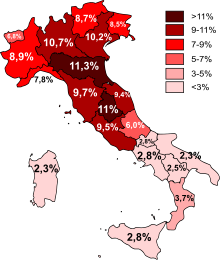
Back الهجرة إلى إيطاليا Arabic Inmigración en Italia Spanish مهاجرت به ایتالیا Persian Immigration en Italie French Immigrazione in Italia Italian Immigratie naar Italië Dutch

In 2021, Istat estimated that 5,171,894 foreign citizens lived in Italy, representing about 8.7% of the total population.[1][2] These figures do not include naturalized foreign-born residents (about 1,620,000 foreigners acquired Italian citizenship from 1999 to 2020, of whom 130,000 did so in 2020[3]) as well as illegal immigrants, the so-called clandestini, whose numbers, difficult to determine, are thought to be at least 670,000.[4]
In 2021, around 6,260,000 people residing in Italy have an immigration background (around the 10.6% of the total Italian population).[2][5][6]
Starting from the early 1980s, until then a linguistically and culturally homogeneous society, Italy begun to attract substantial flows of foreign immigrants.[7][8] After the fall of the Berlin Wall and, more recently, the 2004 and 2007 enlargements of the European Union, large waves of migration originated from the former socialist countries of Eastern Europe (especially Romania, Albania, Ukraine, Moldova and Poland). Another source of immigration is neighbouring North Africa (in particular, Morocco, Egypt and Tunisia), with soaring arrivals as a consequence of the Arab Spring. Furthermore, in recent years, growing migration fluxes from Asia-Pacific (notably China,[9] South Asia, and the Philippines) and Latin America have been recorded.
Since the expansion of the European Union, the most recent wave of migration has been from surrounding European states, particularly Eastern Europe, and increasingly Asia,[10] replacing North Africa as the major immigration area.[7]
Romanians made up the largest foreign community in the country (1,077,876; around 10% of them being ethnic Romani people[11]) followed by Albanians (433,130) and Moroccans (428,940).[12] The fourth largest, but the fastest growing, community of foreign residents in Italy was represented by the Chinese; as of 2021 there were 330,495 foreigners holding Chinese citizenship.[13][14] The majority of Chinese living in Italy are from the city of Wenzhou in the province of Zhejiang.[15] As of 2021, foreign citizens' origins were subdivided as follows: Europe (47,6%), Africa (22.25%), Asia (22.64%), The Americas (7.49%), and Oceania (0.04%).[16]
The distribution of foreigners is largely uneven in Italy: in 2020, 61.2% of foreign citizens lived in Northern Italy (in particular 36.1% in the Northwest Italy and 25.1% in the Northeast Italy), 24.2% in the Central Italy, 10.8% in the South Italy and 3.9% in the Insular Italy.[17]
The children born in Italy to foreign mothers were 102,000 in 2012, 99,000 in 2013 and 97,000 in 2014.[18]
- ^ "Indicatori demografici, anno 2020" (PDF). Archived (PDF) from the original on 3 May 2021. Retrieved 3 May 2021.
- ^ a b "Population on 1 January by sex, country of birth and broad group of citizenship". Archived from the original on 21 January 2023. Retrieved 9 November 2022.
- ^ "Acquisition of citizenship by age group, sex and former citizenship". Archived from the original on 21 January 2023. Retrieved 9 November 2022.
- ^ Elisabeth Rosenthal, "Italy cracks down on illegal immigration Archived 21 August 2013 at the Wayback Machine". The Boston Globe. 16 May 2008.
- ^ "Cittadini Stranieri. Popolazione residente e bilancio demografico al 31 dicembre 2014". ISTAT. 15 June 2015. Archived from the original on 26 October 2019. Retrieved 16 June 2015.
- ^ "Bilancio demografico nazionale". ISTAT. 15 June 2015. Archived from the original on 23 December 2019. Retrieved 16 June 2015.
- ^ a b "Resident foreigners on 1st January - Citizenship". dati.istat.it. Archived from the original on 28 January 2022. Retrieved 7 February 2023.
- ^ Allen, Beverly (1997). Revisioning Italy national identity and global culture. Minneapolis: University of Minnesota Press. p. 169. ISBN 978-0-8166-2727-1.
- ^ "Milan police in Chinatown clash Archived 10 October 2017 at the Wayback Machine". BBC News. 13 April 2007.
- ^ Willey, David (13 April 2007). "Milan police in Chinatown clash". BBC News. Archived from the original on 10 October 2017. Retrieved 28 August 2013.
- ^ "EUROPE: Home to Roma, And No Place for Them". IPS ipsnews.net. Archived 5 March 2012 at the Wayback Machine
- ^ Lanni, Alessandro (27 December 2015). "From Morocco to Romania: how immigration to Italy has changed over 10 years". Open Migration. Archived from the original on 16 March 2016. Retrieved 10 March 2016.
- ^ "Cinesi in Italia". Archived from the original on 9 November 2022. Retrieved 9 November 2022.
- ^ "Società Stranieri in Italia, 5,2 milioni i residenti regolari. Romania e Cina le provenienze con i maggiori incrementi negli ultimi 8 anni". Il Fatto Quotidiano. 20 September 2019. Archived from the original on 15 May 2021. Retrieved 15 May 2021.
- ^ Chang, Angela (24 February 2012). "20th Century Chinese Migration to Italy: The Chinese Diaspora Presence within European International Migration". ResearchGate. Retrieved 11 March 2015.
- ^ "Tuttitalia". Archived from the original on 14 February 2022. Retrieved 14 February 2022.
- ^ "XXIX Rapporto Immigrazione 2020" (PDF) (in Italian). Archived (PDF) from the original on 31 December 2021. Retrieved 31 December 2021.
- ^ Programma, Integra (12 February 2015). "Istat: nel 2014 oltre 90mila i nuovi nati stranieri". Archived from the original on 6 April 2016. Retrieved 25 March 2016.
© MMXXIII Rich X Search. We shall prevail. All rights reserved. Rich X Search